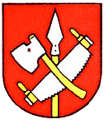Population of Mengusovce, colonisation of the region Spiš
 The first known inhabitants of Mengusovce area were probably people of Hallstatt and Laten cultures (older and younger stone age). This may be judged from preserved hill terraces, which features and reasons of their origin were described by the historian Janšák. According to the historian Munnich from Poprad a beam castle towered above the terraces. In these days there is no proof about it.
The first known inhabitants of Mengusovce area were probably people of Hallstatt and Laten cultures (older and younger stone age). This may be judged from preserved hill terraces, which features and reasons of their origin were described by the historian Janšák. According to the historian Munnich from Poprad a beam castle towered above the terraces. In these days there is no proof about it.
Then the Celts settled here. They were fought by German Quades who left a deserted land behind (tabula rasa), as Munich writes. In the 9th and 10th century the Tatra region was a part of Great Moravian Empire, anyway, by the end of the 11th century the whole territory of Slovakia was a part of Hungarian state. Until the 12th or 13th century, the Slavonic inhabitants of the region Spiš lived mainly as herdsmen, shephards, hunters and primitive farmers. Their dwellings were built half in the earth and covered by pine green.
Between 1241 and 1242 the territorry of Slovakia was deserted by Tatar invasion. After the Tatars left, the Hungarian King Bela IV ordered to built stone castles on elevations (hills) or other suitable places and stone fortifications around the towns. What is more, the king and the nobility invited colonists, mainly from Saxonia (Saxony) to Slovakia to repeople the territory. They entitled them with extensive advantages and rights.
The region Spiš was a sparcely populated area that time and it is evident from the preserved records about house census (house counting - port) from much later time (1561 – 1610). The whole region Spiš could have had something over 4.000 ports (houses), whereas in 1889 there were already 14.133 of them. Mengusovce had 3 houses according to the first preserved records and in the year 1880 there were already 48 of them.The statistics of Spiš of this time show, that apart from these houses there were buildings which were not subject to tax (e.g. cloisters and houses which were cloister property.) This could have referred to further three houses in Mengusovce from the 13th century: a stone church, a parsonage (rectory), which stood next to it and a religious house in which the so-called „kubins“, parish servants, custodians of the church and the parsonage, stayed. On the village hill, there lived the lord's huntsman and "dráb" - the warden (who controlled the subjects) and at the nearby ford, there stood the so-called "búdka" - once probably a sentry box, a tollbooth (tollhouse) on the Via magna – which burned down in a fire in 1923.
To judge on these facts it might be assumed that the Mengusovce area was more densily populated, it means, there were not only 3 houses of village landlords mentioned above.
Property situation of Mengusovce
In 1222 the Cistercians built a Cloister of Blessed Virgin Mary in Štiavnik. In colloquial language the cloister is known as Abbey of Štiavnik. Several villages, the village Mengusovce among them were property of this cloister. This ment that Mengusovce and the Cloister of Štiavnik experienced the same fate (lot, fortune). In 1398 the seventh abbot Ladislav Farkašovský became the owner of Mengusovce (the village was already mentioned under this name) which was a part of his family properties. After his dead he left all his family properties to the Cloister of Štiavnik, herewith Mengusovce, as well.
In 1432 the Hussits (Husitten) destroyed the Cloister of Štiavnik. In the years 1532 – 1538 Mengusovce passed together with Štiavnik on to family Lasky, as present from Ferdinand von Habsburg in appreciation for their help to the Duke of Transsilvania, Ján Zápoľský.
In the years 1542 – 1563 the village was occupied by the captain Loboczy from the town Kežmarok.
In 1563 Albert Lasky put Mengusovce and Primovce in pledge to the townsman Glatz for 535 guilder, what arises from a preserved record (document).
In 1582 Mengusovce became property of family Mariássy: the family bought the village for 1000 guilder. In no way was it a donation (present) on the part of Belo IV to a forebear (ancestor) of family Mariássy, named Botiz in 1264, as explained in history up to now. The village stayed property of Mariássy family until 1907. Then they sold their properties and moved in their castle in Batizovce.
Christianity in Mengusovce
Ancestors of Mengusovce inhabitants were pagans. They adopted Christianity when it arrived to Great Moravian Empire and became Christians. A record from the Evangelic canonic visitation from 1868 reads:
"The christian religion was established in Mengusovce and in the village Štôla, which created together one daughter church, when not in 13th then surely in the 14th century, probably under the name of Kucagel."
Mengusovce must have been Christian since the beginning of the 13th century, because in 1209 it was donated to the provost (Probst – a senior official in Christian churches) Adolf and his sister from Hungarian king Ondrej II. Then the village passed on to Abbey of Štiavnik and in the first third or the second quarter of the 13th century a sacral building - the present church of Sankt Thomas was built. It was built on the highest place of the village near the Big road (Via magna). Around the church, there was an 80cm thick and two metres high wall – the church was enclosed like a fortification. The wall was built of stone bound with burnt lime. However, it is not known, when and by whom the church was built.
Some records about monuments of art of Spiš region confirm that the church is an early Gothic building with Romanesque features from the second third of the 13th century. If we place its building between 1245 – 1250, it corresponds with historical facts. The Sankt Thomas church was last renovated between 1970 – 1972. Nothing was preserved from the original interior decoration. A walled Gothic window discovered in sanctuary was restored to its original state. The rests of a stone wall were pulled down and the cemetery on the southern and the eastern side of the church was closed (liquidated). The two church terrasses of the church hill were sloped into one level. There were also discovered two wall paintings under the upper coat of plaster and an inscription - the year 1748 – the year of probably the latest renovation above the main arc. This renovation revealed the original style – early Gothic with an original portal on the southern side.
In connection with the religious life, it is necessary to mention the Husittes (Hussiten), who left Bohemia on 4th January 1433 and began their campaign through Moravia, Moravian Silesia, Halytsch (Galicia – in Southeast Poland and West Ukraine), behind the Tatras and finally entered the region of Spiš. On 7th May 1433 they already pillaged (marauded) the town of Spišská Sobota and moved on to the village of Hybe (Liptov region – the neighbouring region of Spiš). From (through) the events it becomes evident, that the church of Mengusovce passed on the same day on to Husittes (Hussiten) and served for their religion until their departure in 1460. It is possible that Mengusovce joined (supported) the Husittes, especially when their mother cloister of Štiavnik fell, and so the church survived intact. After almost 30-year-occupation (stay) by Husitts, the Sankt Thomas church was used by ancestors of Mengusovce again until the reformation, however, no names of priests were preserved.
In the years 1518 – 1519 Upper-Poprad Brotherhood (Fraternity) of priests was founded. In their records, there is mentioned the name Kucagel, because it did not pay for the fraternity. The foundation and spreading of the Fraternity over the whole region Spiš was connected with the reformation in the region, started by Martin Luther on 31st October 1517 in Germany. Soon the above mentioned Fraternity was founded between1518-1519. Mengusovce were already its member in 1550. In 1582 the whole fraternity of Spiš adopted the reformation teaching. The people of Mengusovce became Protestants in the half of the 16th century.
Under the emperor Leopold I. an encreased oppression of Protestants began. The recatholisation process proved successful and in 1674 the Fraternity (brotherhood) of priests ceased to exist. In the turbulent period of history protestants had to leave their Sankt Thomas church twice. In 1673 for a short time and in 1710 permanently.
In 1710 it ceased to exist as a mother church and the pastor Mikuláš Maday moved in the vacant pastor station in the village of Batizovce.
Protestants met to their God services in a private house until 1794, then they built a wooden church with an approval of their Lord and the county. The new church stood where today the belfry (bell tower) stands. In 1838 the corner stone of the present stone-built protestant church was laid and after two years of enthusiastic building it was consecrated on the Sunday after the Michal's Day in 1840.
Mengusovce became mother church again in 1954 – after 244 years. The first pastor was Gedeon Mohr.
The youngest Christian community in Mengusovce is the Baptist community. Its beginnings go back as far as 1844, when it began its missionary work in the village. Its prayer house was built between 1942 – 43.
School system and cultural life of the village
The first school of the village was built on a part of community land in 1790 under the teacher Štefan Pazar and as written on the school gate, the "Guest-house for teacher of children" was reopened together with the schoolyard in 1811.
It did not survive a long time and so a new school of wood and on a stone base was built in the same place in 1831. Wood and 25 guilder were a gift from the Lord Andrej Mariássy. The school consisted of a small and dark classroom and of a flat for the teacher: there were a chamber, a hallway, a kitchen and the cellar. Two stables (barns), wood shed and a garner belonged to the house, too.
As early as 1882 began the local people to raise money for a new school. They started to build the school in spring 1888 under the pastor Andrej Bartala, the curator Samuel Gallo, the beadle (church man, assistant) Andrej Gay, the sheriff (village mayor) Andrej Alexay and the teacher Ján Daniš. The school carried the following inscription: "Evangelical elementary school of the Augsburg Confession."
Its stone building stands to the present time, but it was rebuilt and repaired several times. The school had only one classroom where 6 age-groups were taught. In 1948 a kindergarden with 35 children was opened. The first kindergarden-teacher was Eva Nagyová from Kšely near Český Brod.
Every town or village is proud of its well-known natives, or people who lived and worked there for a certain time. The ours are:
Janko Rodoľub Bobris, 1832 – 1912, born in Vrbica near Liptovský St. Mikuláš. At first he was a parish clerk in the parsonage of the pastor M.M. Hodža. Because of his talent, M.M. Hodža supported his studies at the Gymnasium (Grammar school) in Rožňava and at the Lyceum in Kežmarok. In Mengusovce he worked as a teacher from 1851 – 1856.
Michal Šoltys – Šoltis, or Šoltés, 1802 – 1862, born in Mengusovce, pastor of the village Važec, contributed to the newspapers and magazines: Cirkevné listy (Church letters), Slovenské noviny (Slovak newspaper) in Vienna, under the mark „Spod Kriváňa“ („From under the Kriváň peak“ – Kriváň is the national symbol of Slovakia).
In 1845 – 1848 Slovenskje národnje novini (Slovak national newspaper) published his letters and the magazine Orol tatranský (Tatra eagle) his article about Slovak literature. In 1852 the magazine Slovenské pohľady (Slovak views) published his further article "What do we Slovak need?".
Karol Plicka, professor and national artist, photographer. He began to discover the High Tatras from Mengusovce on between 1924 – 1925.
Ľudovít Manco, 1905 – 1968, born in Závažná Poruba, began to work at the local teacher and cantor station as a teacher beginner and he worked here until he retired – 41,5 years. He taught and raised several generations of children and while his teacher carreer he also supported the development of community theatre (amateur dramatics).
The tradidion was continued to a lower extent by the teacher couple Hroš, but as soon as the school in Mengusovce was closed the amateur theatre stopped working.
Development of the village
The original village were in reality farmsteads (granges)/(hamlets) scattered over the village area. In the course of time the location of the village changed many times. It lasted whole centuries, until the custods moved slowly from the border of the Liptov region to the church on the present community lands. They abode at the place for about three centuries and sat out reformation, antireformation and all the uprisings and persecutions. Down to the present days the place above (upside) the original village is called „Vyše vsi“ („Above the village“). At the beginning of the 18th century the village moved on the present territories. It burned down many times, in 1713 to naught (embers).
In 1720 only 6 village landlords were in the village. It is supposed, that in that time the wooden estate Drevený majer (Wooden manor) in Hliniská (Clay area) burned down as well. According to a conscription from 1831 the village spread on Pahvorky (The terraced hill), so the Sankt Thomas church was then the last building at the upper end of the village. This did not happen at once, but it lasted full 200 years (1703 – 1903) – as the inscriptions in beams of old log cabins confirm. In 1900 there were 54 houses in Mengusovce together with school and two churches. Only 5 of them were the so-called "muranice" (stone-houses). In one courtyard cramped 5 to 6 families.
In the first third of the 20th century the village was destroyed by two great fires. At first the upper part of the village burned and inthe night from 20th to 21st Mai 1921 a great fire destroyed the whole lower part of the village. A chronic reads: "It came out of the Mlynar's sty and destroyed 16 houses of village landlords completely."
In the First World War 7 inhabitants of Mengusovce died. Their names are on the memorial plaque in the Evangelical church. The Second World War claimed only one life – it was Ondrej Šoltýs whose father died in the First World War. Ondrej Šoltýs joined the Slovak National Uprising against fascists, wounded he was deported to a concentration camp where he died. After the Second World War in 1946 a resettlement to the southern border of Slovakia began. 7 families, 33 people altogether, left Mengusovce for the town Šaľa-Veče (near the Slovak-Hungarian border).
When the after-war crisis had been overcome the village developed and grew. In 1980 Mengusovce had already 129 houses.
Extract from the publication published (released) at the instance of (by reason of) 600-year celebration of the first written record about Mengusovce.
Author: Ing. Pavol Rataj





